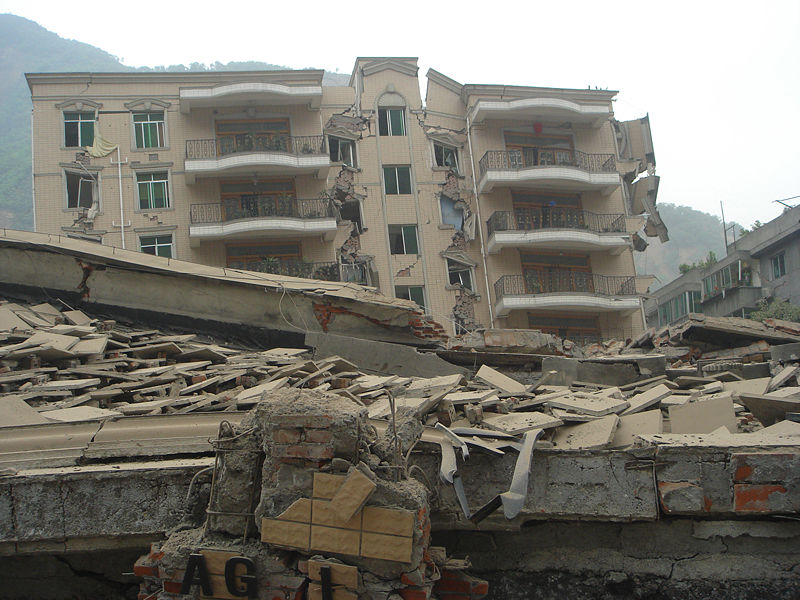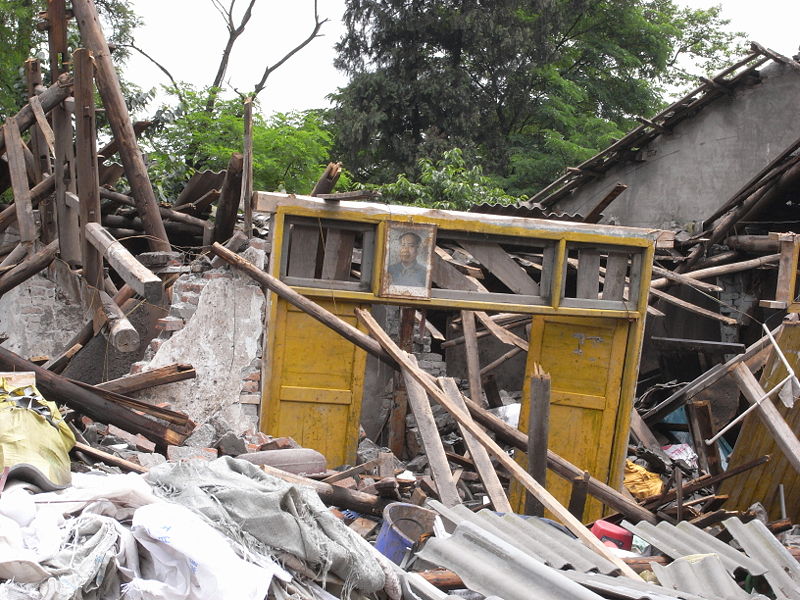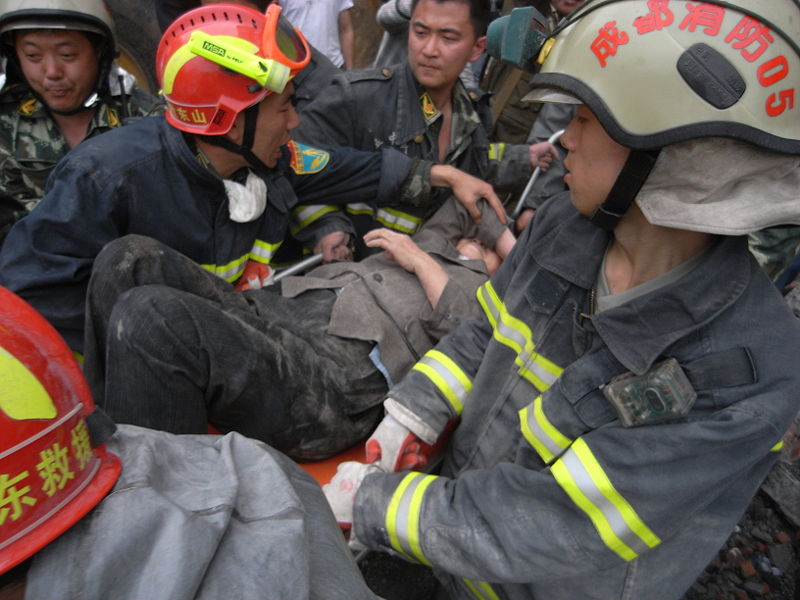Earthquake in Sichuan, China, May 12, 2008
 After the earthquake: a bank in Beichuan where a girl was found after four days.
After the earthquake: a bank in Beichuan where a girl was found after four days.
In the News
Initial News Coverage
“The Day the Earth Moved”
China Daily/Xinhua, May 13, 2008
—This coverage includes reports from different towns and cities around Chengdu, the capital of Sichuan Province. While President Hu Jintao orders official to make full-fledged efforts to rescue survivors and help casualties, tremors were perceived as far away as Vietnam. Includes graphic showing numbers and locations of the dead, as reported at the time.
“Powerful Quake Ravages China, Killing Thousands”
By Jake Hooker and Jim Yardley, New York Times , May 13, 2008
—The initial shock ruined 80% of buildings near the epicenter at Dujiangyan, including communication facilities, which has isolated the quake-affected areas from other part of the country.
“Hundreds Buried' by China Quake”
British Broadcasting Corporation (BBC) , May 12, 2008
—The initial wave of the earthquake sends the residents into a panic. While Premier Wen Jiabao is on his way to the area, a number of people, including 900 children at a school, are left buried under flattened buildings. Includes video clip.
“Earthquake Rocks China's Sichuan Province”
National Public Radio (NPR) , May 12, 2008
—The radio stories at this link feature reports from NPR's Melissa Block and Robert Siegel, who happened to be in Sichuan Province at the time of the quake and witnessed rescue efforts at a hospital and at a school. Includes a recording of the quake in progress.
“Earthquake Rocks Western China, Killing Thousands”
By Gwen Ifill and Austin Ramzy, NewsHour (Public Broadcasting Service [PBS]), May 12, 2008
—NewsHour's Ifill interviews Time Magazine's Ramzy, who was on the scene.
Poorly constructed housing and building result in a high death toll. Includes streaming video, audio only, and transcript.
US Geological Survey information on the May 12 Eastern Sichuan Earthquake
—U.S Geological Survey offers scientific information on the May-12 Earthquake, including maps and comparison grids with other historic earthquakes.
Follow-Up Reports
Full New York Times Coverage to Date
—Lists all New York Times stories related to the May 12 Earthquake. Also at this link: earthquake-related headlines from around the web, Earthquake Q & A from Times reporters in China, a list of agencies providing relief, and several vivid slide shows depicting different ways the Chinese people have been affected.
China Earthquake in Video
—Several video segments to date, broadcast on the BBC, depicting dramatic moments of the May 12 Earthquake and its aftermath.
"Life in Limbo for China's Quake-hit"
By Daniel Griffiths, BBC News, June 12, 2008
—Profiles one family's circumstances, one month after the earthquake that has killed tens of thousands and left millions homeless.
“River Threatens China Quake Survivors”
By Andrew Jacobs, New York Times, May 29, 2008
—Landslides have caused the damming of rivers, which resulted in the evacuation of about 1.3 million residents in the surrounding areas. Now, soldier and engineers work on water diversion to prevent banks from breaking out.
“China Seeks Earthquake Aid from Japan”
CNN, May 29, 2008
—After sending medical teams, Japan plans to dispatch its Self-Defense Forces as relief aid for China. However, the involvement of Japanese military provokes popular resentment even 70 years after the Japanese invasion of China .
“Post-Quake Challenge: 5 Million Homeless”
Associated Press/MSNBC, May 20, 2008
—After the first shock of the earthquake, the area in Sichuan and Chongqing faces problems. The collapse of school buildings amongst other undamaged buildings buried 900 students. The government set up temporary housings for about 5 million homeless people. The death toll keeps rising.
“Disease Outbreak Prevention Crucial in China Earthquake Aftermath”
By World Health Organization, May 17, 2008
—Securing safe water is the key for China 's recovery from the earthquake. Now, officials are concerned with the possibility that communicable disease will spread due to inadequate water supply.
“Taiwan Offers Help After Deadly Earthquake in China”
By Patrick Goodenough, Cybercast News Service , May 13, 2008
—Without an official channel, Taiwan offers relief aid to China , which does not recognize it as an independent nation. (See also "Help with a bow," The Economist, May 29, 2008.)
 A single door frame with a portrait of Chairman Mao remains standing in the debris.
A single door frame with a portrait of Chairman Mao remains standing in the debris. Analysis and Opinion
“China's Earthquake May Rattle the Political Landscape”
By Dan Rather, Seattle Post-Intelligencer, May 23, 2008
—In addition to countless victims and refugees, the May 12 Earthquake poses another problem—new “openness” that has allowed media coverage and wide access of foreign relief forces to various devastated sites. Will this challenge the control of media which Chinese government has exerted for a long time?
“China Helps Itself.”
Editorial, The Economist, May 22, 2008
—The growing Chinese middle class willingly share their money with the victims of the May-12 Earthquake. Civilians voluntarily get themselves involved to provide not only food but also counseling and electricity for mobile phones.
“Will the Earthquake Bring China and Japan Closer Together?”
By Robert Vance, The Teaching China Web, May 19, 2008
—Different reactions of Chinese people toward Japanese relief aid. Will Japanese effort to help Chinese people recover from the earthquake cast hope for the friendship between two countries?
“China Shows a Human Face with Earthquake Rescue Mission”
By Con Coughlin, Daily Telegraph, May 16, 2008
—Compared with George Bush's response to Hurricane Katrina in 2005, China 's Prime Minister Wen Jiabao's seems compassionate towards victims as he repeatedly appears in public. Also, he has been able to deploy military force in a prompt manner. But, can the nation with the largest population present the same attitude toward all in and on its national borders?
“Chinese Quake Shows Change in Winds Across Asia”
By William Pesek, Bloomerg, May 15, 2008
—The China 's May 12 Earthquake will shed new light on the international relationship among East Asia's big three: South Korea, Japan, and China itself. In particular, the openness of Chinese government to accept foreign aid will be maintained and applied to its foreign policy with, for instance, Japan, whose Prime Minster Yasuo Fukuda is now eager to work with China.

An elderly woman was rescued and placed on a stretcher after being trapped for over 50 hours.
Comparing the Chinese Earthquake and Myanmar's Cyclone Nargis
“China Quake Toll Rises to 60,000 - UN Chief Makes Surprise Visit”
By Deutsche Presse-Agentur, The Nation Headlines, May 25, 2008
—United Nation's Secretary-General Ban Ki-moon comments on two governments' responses based on his first-hand account.
“A Tale of Two Disasters: Cyclone Nargis in Burma, Quake in China (Commentary)”
Mizzima News, May 19, 2008
—The responses of Burmese and Chinese governments to the natural disasters stand in stark contrast to one another.
“Don't Divert Aid for Myanmar Because of Chinese Quake, Agencies Say”
By Tiffany Crawford, The Vancouver Sun, May 13, 2008
—Because of the initial impact of media coverage, the May 12 Earthquake in China may divert popular attention from the Myanmar cyclone.
Lesson Plans
“Earthquakes: A Whole Lot of Quakin' Going on”
National Geographic Society
—This lesson plan (grades 9-12) is designed to familiarized students to various contributions earthquakes can make. Although not specific to China, this will teach not only basic knowledge of earthquakes, such as how to measure them, but also their consequences for people. It can be accompanied by the National Geographic film Forces of Nature.
Understanding Earthquakes: Learning from Kobe
National Geographic Society
—The purpose of this lesson (grades 6-8) is to understand earthquakes, using the case study of the 1995 earthquake in the port city of Kobe, Japan . Topics include the causes and effects of earthquakes, and why some locations on Earth are more prone to earthquakes than others. The Kobe earthquake can provide a case study for comparison of cause, effect, recovery, and preparedness.
Video Resources
Fire on the Rim: Understanding Earthquakes from the Experiences of the Pacific Rim
PBS, 1990
This four-volume set of documentary describes the ways in which people living in “the rim of fire”—30,000-mile rim of the Pacific Ocean where 75% of active volcanoes of the earth is located—cope with natural disasters such as earthquakes. These videos offer a intriguing view to bridge the fields of science and social studies.
Search the AEMS Database for more information
Last Updated: July 27, 2012

